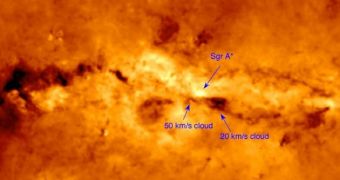A new series of investigations has revealed the presence of a twisting, fast-moving stream of gas clouds swirling around the center of our galaxy. The structure was detected in the far-infrared portion of the electromagnetic spectrum, and is believed to be very cool.
The discovery was made using the European Space Agency's (ESA) Herschel Space Observatory. According to the earliest analysis of the feature, it would appear that it has a mass of about 30 million Suns, experts say.
It extends for 100 by 60 parsecs, the equivalent of 326 by 196 light-years. When viewed from the side, such as from our position in regards to the galactic center, the structure resembles an infinity symbol.
This optical effect is caused by the fact that the spinning gas stream oscillates two time in regards to the galactic plane for every single orbit it makes around the core. The galaxy features a supermassive black hole at its center.
Investigators believe that the unusual movement patterns the rings exhibit can be accounted for by taking into consideration the lateral movement of gas in the large central bar of the Milky Way.
In addition, the spin of the central galactic bulge is also influencing the clouds. The overall result was imaged using the Photodetector Array Camera and Spectrometer (PACS) instrument on Herschel.
Interestingly, the device also indicates that the gas maintains an average speed of 10 to 20 kilometers per second for most of its path around the galactic core. However, at a specific location, gas speed can exceed 50 kilometers per second.
According to astronomers, this difference is caused by the close proximity between the clouds and Sagittarius A*, the supermassive black hole powering up the core of our galaxy. The immense gravitational pull the object is exerting is causing matter to accelerate.
Still, only a portion of the ring is influenced by the black hole, with the remainder being subjected to the effects caused by the galactic bulge. This happens because Sagittarius A* is not located right in the middle of the gas ring.
Experts say that the new discoveries might yield more insights into the evolution of the galactic core. The way the Milky Way came to be fascinates astronomers, who believe that they can clear this mysteries by studying its core, Universe Today reports.

 14 DAY TRIAL //
14 DAY TRIAL //